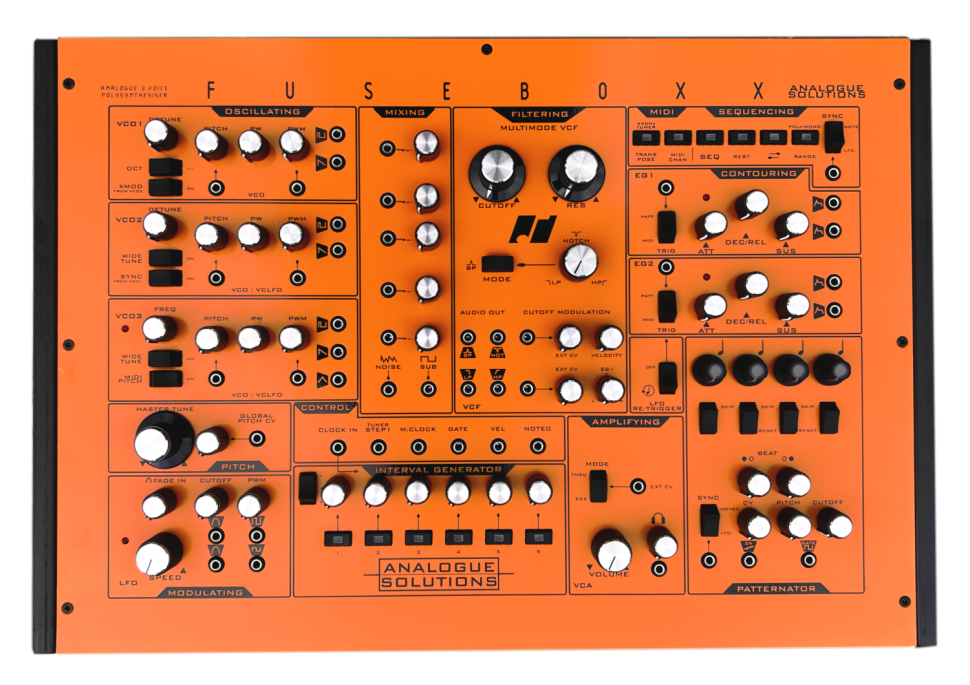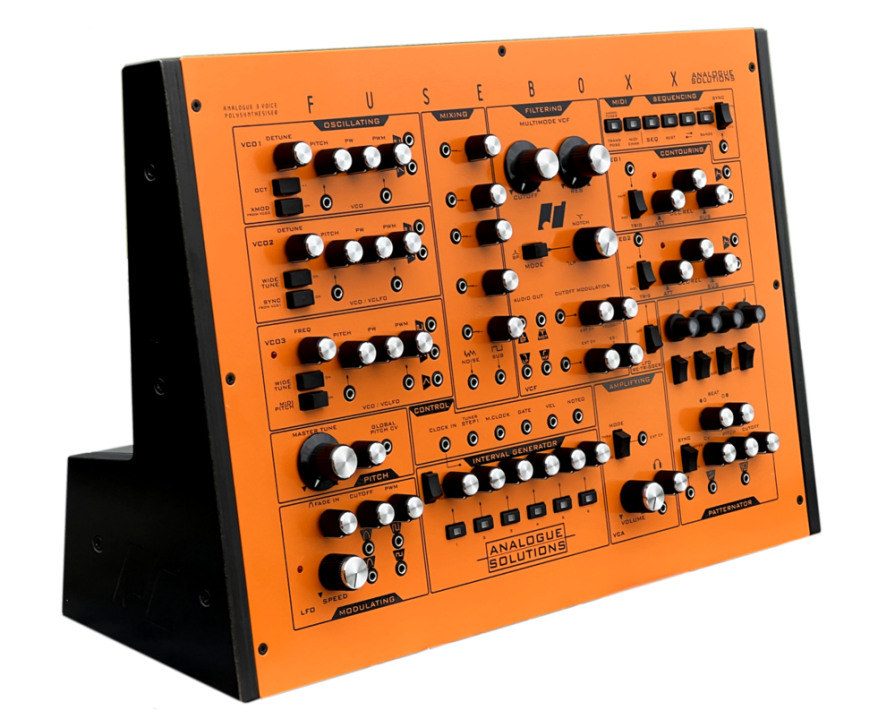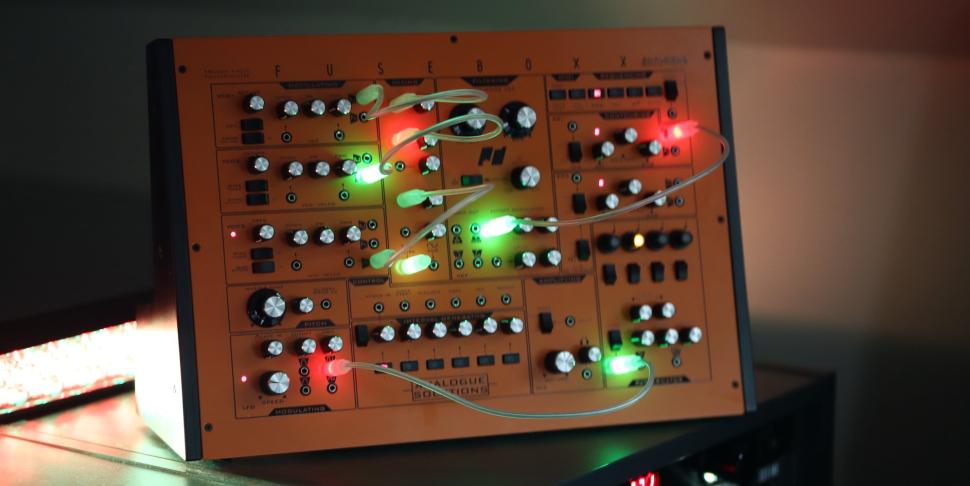Test: Fusebox X

With the Fusebox X, Tom Carpenter once again focuses on uncompromising vintage analog sound, garnished with unusual new features. The successor to the Fusebox, released a good five years ago, comes up with some improvements. Fusebox X is now three-voice paraphonically playable and additional patch jacks expand the possibilities of this semi-modular synthesizer. The three oscillators with their raw, punchy sound and the SEM-style multimode filter have remained. The combination of Patternator and Interval Generator is a guarantee for independent and unusual sequences and has also been refined in every detail; the arpeggiator has been replaced by a step sequencer.
A real eye-catcher!
Once set up, the Fusebox is hard to miss, whether in the studio or on stage. This is due not only to the eye-catching orange paint, but also due to the size of this solid and well-made metal housing featuring wooden side panels that measures 45 x 14 x 30 cm and weighs just under 10 kilograms. When delivered, the Fusebox X can be set up almost vertically, similar to a table rack, which makes the synthesizer look even more impressive; however, the stands can also be mounted in such a way that an only slightly angled set-up is possible, although the Fusebox then also requires some depth on your studio table. When using the optionally available rack brackets, the Fusebox X can also be installed in a 19“ rack, where it takes up seven rack spaces.
The MIDI trio, audio output and power supply connection are integrated in the stand and let the plugs of the cables virtually disappear behind or under the surface when the desktop is set up, which is practical and space-saving. All other connections, including the headphone output and various patch jacks are placed directly on the surface of the Fusebox.
Plenty of room to tweak
Thanks to the generous dimensions, there is enough space between the 54 controls, which are completed by numerous buttons and switches. Even people with large hands will have no problems tweaking their sounds. The knobs offer an excellent feel with a pleasant resistance when turning them. They are available in different sizes, whereas the mini knobs of the previous version (for Interval Generator and Patternator) have fortunately been replaced by normal sized pots in the new X version. The knobs for controlling frequently used parameters such as Filter Frequency and LFO Speed have been made slightly larger. This is not only practical, but also visually increases the clarity.
Three oscillators
The pure analog sound generation is based on three oscillators. VCO1 offers sawtooth and square waveforms with adjustable pulse width. It can be fine-tuned and tuned one octave higher and cross-modulated with VCO2 for metallic sounds. Pitch and Pulse Width have modulation inputs with adjustable intensity. VCO 2 is basically the same, instead of cross modulation, a switch activates a hard synchronization to VCO1. The control range of the Detune parameter can be extended significantly via the Wide button, which allows tuning over several octaves and to use it as an additional LFO. VCO3 also features the Wide switch; it can additionally be decoupled from the played pitch for modulation purposes and has a triangle wave as its third waveform. VCO3 is also responsible for the sub-oscillator, which sounds one octave lower as a square wave. The new 440Hz tuner makes it easier to adjust the pitch.
Semi-modular
Each of the seven waveforms of the three VCOs has a separate output jack and can, in this way, not only be looped into a modular system unprocessed, but also modulate the filter frequency internally, for example. A total of 48 freely connectable patch jacks in Eurorack-friendly mini-jack format turn the Fusebox into a semi-modular synthesizer and allow you to break up the hardwired circuits and link them to other analog equipment.
3-way paraphonic
In the mono setting, all three oscillators play simultaneously with each keystroke, which makes for fat Minimoog-style sounds when detuned appropriately. A new addition to the Fusebox X is the option to play the synthesizer paraphonically. When Poly mode is enabled, you can control the pitch of each oscillator separately and finger three-part chords on the keyboard or otherwise play the synthesizer polyphonically, such as a melody over a running sequence. Since the oscillators still only travel through a filter and an amplifier, this is not comparable to a real polyphonic synthesizer like a Roland Juno, but in any case, a useful extension. In combination with crossmodulation, even weird sounds in the style of an ARP Odyssey are possible when several notes are played simultaneously. A global pitch input allows simultaneous pitch modulation of all oscillators, for example, for a vibrato on the chords.

Advanced mixer
In the mixer section, the outputs of the oscillators are mixed together, and you‘ll also find the outputs for the noise generator and sub-oscillator here. In contrast to the previous model, all five mixer inputs now have a free socket, so they are no longer hardwired to VCO 1 and VCO2 via toggle switches. This makes Fusebox X even more flexible, also in connection with external sound generators.
Multimode filter
From the mixer, it goes into the multimode filter featuring a 12 dB slope. In addition to adjustable Filter Frequency and Resonance, the filter type can also be steplessly crossfaded between Lowpass, Notch and Highpass or set to Bandpass mode via a switch. This design is, of course, strongly reminiscent of the legendary Oberheim SEM filter, which Analogue Solutions has already presented in a similar form in other products such as in the Telemark. However, it is not a slavish copy, but an independent design, which sonically also shows influences of the legendary Moog �Ladder filter.
Flexible use
All four filter types can be tapped simultaneously via individual outputs if required, for example, to combine low-pass and high-pass. The modulation options are also pleasingly extensive; in addition to Velocity and Envelope 1 (positive or negative), two controllable inputs are available for free wiring, which can be used for LFO modulation, keyboard tracking or FM, for example.
Amplifier
The signal chain is completed by the amplifier with its large volume control. A toggle switch lets you set whether the volume is dynamically modulated by Envelope 2 or a source connected to the Modulation Input, such as LFO or Velocity. In the Thru position, the amp is always completely open, which is interesting for drones or filtering external sources like a drum loop.
Analog envelopes and LFO
For modulation sources, the Fusebox offers two envelopes and an LFO, which are purely voltage-controlled, just like the complete signal path. In many analog synthesizers, especially newer ones, the envelope and LFO are calculated digitally. Due to the power of modern processors, this is no longer as big a disadvantage as it was in earlier years, where weak processors resulted in limp envelopes and slow LFOs. Nevertheless, analog modulators also contribute to the typical vintage analog sound that we often miss in neo-analog synthesizers.
Modulator or clock
The LFO offers the sine and square waveforms. Sine can also be delayed for classic vibrato. The modulation of the Filter Frequency and Pulse Width (PWM) via sine wave is pre-wired. For both waveforms, however, there are also outputs for free switching, and conveniently in each case in duplicate - this saves a splitter. The square wave can also be used as clock signal for Sequencer and Patternator. Unfortunately, you have to do without a synchronization to an external clock because of the pure analog design of the LFO.
Flexible envelopes
The two envelopes are of classic ADSR design, but Decay and Release have to share a knob in classic Moog style. They are triggered by MIDI note, the Patternator or an analog trigger signal connected to the clock input. The envelopes can also be triggered by the LFO and, thus, be used like an LFO with variable waveform. Each of the envelopes also has two outputs. Since VCO2 and VCO3 can also be used as LFOs, you have a lot of options for shaping the sound.
New step sequencer
The built-in step sequencer records up to 16 notes played via MIDI; rests can also be programmed. Similar to an arpeggiator, the stored sequence can be transposed, played forwards and backwards and extended by an octave during operation. This sounds simple at first, but in combination with the Patternator and the synchronizable Interval Generator, it also allows complex patterns - with intuitive operation and direct access!
Patternator
The Patternator allows you to create your own rhythmic patterns and modulations. When the trigger signal is received, the values set via four knobs are output in sequence, and the LEDs built into the pots serve as a running light indicator. With four switches, you determine whether a step is active, skipped or represents the end point of the sequence. The output values can directly modulate the Filter Frequency and Pitch or be linked to any other destination via the CV output. The Fusebox X adds two beat controls that let you create rhythmic patterns. The left knob is responsible for the even counters in the beat, the right knob for the odd ones. If both knobs are set to the left, no trigger is sent. If both sliders are set to the right, all 8 triggers in the bar are sent, in other words, a staccato sequence. By setting both knobs to different values, you can quickly and intuitively create exciting rhythms.
You can call up the trigger sequence via a gate output, and the two envelopes are already pre-wired accordingly. With the combination of a four-stage CV sequencer and an eight-stage gate sequencer, you can create a lot of interesting patterns quickly and directly, especially since the sequencer can still run in parallel.

Flexible triggering options
Both the Sequencer and Patternator have their own sync input. In addition to an external source, the LFO can serve as a clock generator, so that the Fusebox can rattle away autonomously even without an external sequencer. You can also select MIDI clock for synchronization using the built-in MIDI CV interface, but the MIDI note variant is more interesting when a DAW is connected. If you connect the very low MIDI note 000 (=C-2 on the keyboard) to the Fusebox, it does not control the pitch, but advances the sequencer one step further. In most cases, this not only works more reliably than synchronization via MIDI clock, but is also much more flexible. Then you are not limited to straight rhythms, but can program any patterns in the DAW, with which the individual steps of the sequencer and/or Patternator are switched on. This expands the rhythmic possibilities once again considerably.
Synchronous transposition aid
The Interval Generator is another performance feature. With its six knobs, you can set different note intervals, which can be selected directly with the buttons below. Quickly transposing the current sequence by an octave down and then a fifth up at the touch of a button is, therefore, possible without any problems, which seems to be particularly interesting for live use. Since the interval generator works in an analog and unquantized way just like the pattern generator, even messy transpositions in the style of old DAF bass lines are possible. A new addition in the X version is an external clock input, so that the transposition can be synchronized to the song tempo.
Comprehensive MIDI-CV interface
The Fusebox is completely analog; you won‘t find digital processors here. Accordingly, the individual parameters do not send and receive MIDI controllers and you also have to do without memory. The only exception is the digital MIDI converter. On the one hand, it ensures that the notes of the sequencer are sent out to control external MIDI equipment. That‘s why the Fusebox also has a MIDI output. In addition, the processor serves as a MIDI-CV interface. Using the 4 sockets on the front, Note Length, Velocity, MIDI Clock or the previously described MIDI Note 0 can all be accessed and routed to the desired destinations. This allows you, for example, to trigger the envelope only on single notes or to advance the Patternator from a connected keyboard via a low note.
Raw, unpolished analog sound
Those who are familiar with the previous model and the other synthesizers from Analogue Solutions can guess what to expect in terms of sound after the description of the possibilities: Raw, unpolished analog sound with proper power and punch! The filter can snap nicely and does not thin out; even at high resonance values, the envelopes are wonderfully fast. In combination with the powerful, overtone-rich sound and the sequencers, classic Synthpop patterns in the style of Vince Clarke are quickly and convincingly created, which has already earned the Fusebox the moniker „Instant Depeche Mode“; but „very British“ describes the sound character quite well. The slightly punky sync sound, which can be tweaked in the direction of Arp Odyssey, also allows typical EBM bass lines in the style of DAF and Nitzer Ebb, especially since the Fusebox also provides decent power at the bottom. Creamy leads and warm atmospheric sounds are less its strength. For this, a Moog is still the better choice, because the Fusebox always retains a certain sharpness and hardness even with the filter closed.
Verdict
Like its predecessor, Fusebox X offers a convincing and uncompromising vintage analog sound, but has become even more flexible thanks to some detail improvements. Three powerful and overtone-rich oscillators, plus suboscillator and noise, a good-sounding multimode filter, as well as fast envelopes, provide fat and assertive sounds that can now also be used more melodically thanks to its 3-voice paraphony. The innovative concept of a step sequencer, pattern generator and flexible trigger option offers new ways to create interesting sequences quickly and intuitively. Due to the extensive MIDI-CV interface and the semi-modular design, the Fusebox can also be excellently combined with other equipment. Only the fairly high price speaks against an unrestricted purchase recommendation
Want more? Get more!



Subscribe to the digital edition of BEAT Magazine via Plugins-Samples.com and get more gear, in-depth workshops, reviews and 11 GB exclusive plugins and new sounds with every monthly issue!
Subscribe to Beat Magazine for only 4.99€ per month
